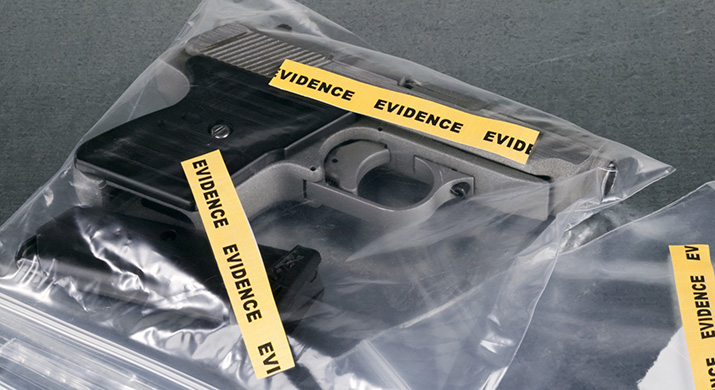The life cycle of crime scene evidence
June 11, 2018

If you’re like most of us, you learned everything you know about evidence from cop shows. The real thing is not as simple and may or may not be missing the surly but lovable evidence locker guard with the heart of gold. To find out what happens to evidence after intake, let’s follow a gun used in a crime and see what happens to it.
A law enforcement officer has two options to get the gun to a BCA Evidence Intake Sections in Bemidji, St. Cloud or St. Paul: They can send it via mail service or hand deliver it. The law enforcement officer also provides specific forms that give BCA personnel the appropriate information and case details to assign examinations.
BCA personnel takes the information provided with the gun and enters it into the Laboratory Information Management System (LIMS). The information entry includes key details such as the type and date of offense, the case number assigned by the law enforcement agency, information on the person involved in the crime, a description of the gun and laboratory testing assignments.
Another important thing that happens when the law enforcement officer turns the gun in to the Evidence Intake Section is that the gun gets a unique barcode and item number, and the officer gets a receipt. The barcode allows the gun – or any piece of evidence – to be scanned individually so that the LIMS system can track it through a chain of custody. Then the BCA takes the gun to be scanned into a secured evidence vault until it’s time to test it.
The tests the BCA runs on any piece of evidence depends on what type of item it is, what type of investigation it’s part of, and what the law enforcement agency hopes to learn from it. In the gun’s case, the agency might want to know who fired it, whether it was fired, and if so, whether a bullet fired from the gun matches one recovered at the scene of an incident. In that case, the gun would pass through the Biology Section for DNA testing and the Criminalistics Section for latent print and firearms analysis.
Once BCA personnel are done testing the gun, they scan it back into vault storage and write a report about the results. They send this report through a technical and administrative review process before releasing it to the law enforcement agency that brought the gun in. Once the agency approves the report, the BCA returns the gun to them, either by hand delivery or mail service.
If the case goes to court, any BCA personnel who handled the gun (that is, anyone who was in the chain of custody) can provide testimony about the handling of evidence in the case. And any BCA scientist who tested the gun can give expert court testimony and opinions on the testing process, accreditation of the laboratory and/or the results of the test.
So next time you’re watching evidence handling on your favorite cop drama, remember that it’s more than it appears on the screen.

